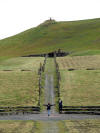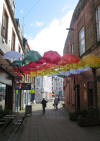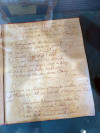



Day Five - Drive to Keswick - Crawick Multiverse and Robert Burns House in Dumfries
return to 2019 UK trip index
return to mdimage site index
Our 8 am breakfast at the Crofthead Farm B&B, in Tarbolton, was delicious, and the generous owners gave us a half-dozen eggs to take south to Keswick, England, today's destination.
In the breakfast room we met a pleasant (older than us) Scottish gentleman and his wife. During breakfast, the B&B owner/husband & cook came out and started to make fun of him, of his longish hair at his age, and, the gentleman was introduced to us as "Robert Burns' older brother." He also asked the gentleman's wife if she ever had a chance to get a word in? She looked into the distance and said "rarely" and then she laughed.
It was spontaneous theatre, ludicrous & hilarious. The gentleman laughed the most, and seemed genuinely appreciative of this obvious display of Scottish affection !
Before the trip, my wife & I had read Naked Scotland, An American Insider Bares All, by S. Blyth Stirling, clueing us in to this odd affection/insult thing, which she said is part of Scottish everyday life. Having lived there for 6 years, the author writes that 'you will know when new Scottish friends start to warm up to you, because you'll suddenly be the target of all the barbs'.
After the owner/cook returned to the kitchen, the gentleman, post-ritual & unperturbed, resumed talking with us, saying that he & his wife have stayed here before, on the same weekend each year, to attend a Classical Music competition in Ayr. He seemed an interesting character & the owner was, after all, recognizing a return customer.
note - you can enlarge any part of a picture by left-clicking in and then out again.
 |
Tarbolton sunrise |
 |
looking north from bdrm. window |
 |
why the eggs are so good > |
 |
Robert Burns didn't have an older brother, but he did live in Tarbolton. Burns' father rented a farm here, but was not successful. More important, when Robert & his younger brother Gilbert were in their early 20s, they formed the Bachelor's Club, in a modest two-story building at the main crossroad in Tarbolton, which is still here & tour-able.
Burn's modern biographer Robert Crawford (see ref. below) writes that the Bachelor's Club is probably the most authentic of all of Burns' shrines, because it is still in original condition. But we had a long distance to drive, and left town more than an hour before it opened for the day.
The Bachelor's Club (2nd floor above a pub) was a debating society for young men from the area, most of whom were self-educated at home, or, had a tutor, or, attended some school (during the 1770')s. In this respect, Robert & Gilbert Burns were well-read & educated, thanks to their father's amazing literary influence as well as the tutors he hired. Robbie Burns grew up during the Scottish Enlightenment era and became part of it.
About Robert Burns's musical background - his red-haired mother Mary Browne was said to have a beautiful voice, and was from a family with deep roots in traditional Scottish songs & ballads. Young Robbie grew up hearing such ballads, including bawdy ones, sung every day.
His earliest biographers gave a lot of credit to his Mom's widowed relative Betty Davidson, who for years helped around the house, and between the two, they planted the musical seed in young Robert which led to his becoming a virtuoso musicologist of Scottish traditional music.
When Robert Burns was in his mid-20s, having achieved success as a Poet, he fondly wrote that Betty Davidson "had, I suppose, the largest collection in the county of tales and songs concerning devils, ghosts, fairies, brownies, witches, warlocks, spunkies, kelpies, elf-candles, dead-lights, wraiths, apparitions, giants, enchanted towers, dragons, and other trumpery." (see ref. at the bottom of page)
Burns published two large, well-received books in 1786 & 87, which were a collection of his original poetry & re-worked traditional Scottish songs. He had a special talent for improving auld lyrics & tunes.
Robert Burns (1759-1796) was first & foremost a farm kid, and his Father struggled year in & out, but never did well, always living in debt, at the edge of poverty. Early biographers suggest that Burns' health was probably compromised at a young age, due to back-breaking toil, being the oldest boy, expected to do more on the farm, and Scottish winters then were more harsh than now.
More on Burns below...
) |
Dumfries & Galloway area |
On the map, we stopped at Sanquhar, and later at the Burns House, in Dumfries. At the lower right is Carlisle, England.
It was one of the longest driving days of the trip, and we enjoyed stopping part-way to walk around Crawick Multiverse, a 55-acre landscape sculpture by Charles Jencks, an American. The one page handout for this site says that Jencks used stone "in the megalithic monument tradition." His 'north-south' line is a 400-meter long avenue, flanked by 300 boulders.
Site history, from the Docent in the visitor trailer: The Duke of Buccleuch, the local landowner, in 2009 decided to remove a 30-year old landscape eyesore, which had been an unproductive open-cast coal mine. He also wanted to create jobs in the nearby village of Sanquhar. A million pounds were granted for site restoration and "the renowned artist, theorist, and designer Charles Jencks" was asked to design & build Crawick Multiverse, only using materials found on site. Environmental restoration was included.
The Duke's plan worked, and the economics of the Sanquhar area has improved. The Docent said she is from there and has a natural resources degree, working here full time. She said four other locals work here full or part-time, and, that more tourists are booking in-town overnight stays and eat at local restaurants.
She added that in one year, site admin/ops staff will have a modern visitor center in which to work. I think we had to pay a few pounds and it was certainly worth it. We spent about 90 minutes here, getting in a decent uphill walk. It was an overcast day with flat light & you might notice wind mills on distant hills.
note - you can enlarge any part of a picture by left-clicking in and then out again.
 |
 |
 |
Cosmic Collisions | ||
 |
the 'north-south' line |
 |
 |
||
 |
 |
 |
|||
 |
 |
ahead is the Omphalos, the center of the world |
 |
||
 |
Andromeda & Milky Way galaxies merging |
 |
 |
||
 |
 |
 |
|||
 |
above the Multiverse |
 |
an incredible place |
The major theme at the Multiverse is the inevitable collision/merging of the Milky Way & Andromeda galaxies, eons into the future.
Burns House in Dumfries
Our next stop was at Dumfries, Scotland, to see the attractive brick home of Robert Burns, his last home. Burns was most content here, finally earning a salary sufficient to avoid having to farm, and, he had an enjoyable life with his dedicated wife Jean Armour and their three children.
Having published two extensive books of poems & ballads, Burns was widely read & appreciated, but intellectual property rights were primitive & he never profited from his writings, although his publishers & printers certainly did. Both times, he didn't expect his books to sell and sold his publishing rights on the cheap, seems to be the story.
In his 30s, a friend helped Burns get a Government job, as an Excise Agent, working from Dumfries. Excise men had to patrol & try to thwart smuggling along the Atlantic coast, as well as shut down & arrest operators of illegal distilleries (inland) in Cumbria, England, where the Lake District is. This was an unrealistically large territory to be responsible for, especially on a daily basis. (see Burns family history note way below)
Mid-winter (1795-96) when two of his older field staff became ill, Robert Burns had to fill in, meaning long hours on horseback, six days a week, no matter the conditions. A long & treacherous winter ruined his health and after declining through the Spring, he died of rheumatic fever in July, 1796, age 37.
Hard to believe such a poor, humble, and short-lived poet would become the Scottish National Bard, or, that 200 years later, his poems & ballads would have been translated into at least 50 languages.
Burns really was humble & never would have believed that one day, people around the world would sing (or mouth the words to) his improved song, Auld Lang Syne, which to us conveys an important emotional element, as we see out the old year & see in the new.
Somehow a simple pub song in his hands over time morphed into a global masterpiece.
 |
River Nith at Dumfries |
 |
falls by the old bridge |
 |
umbrellas downtown |
 |
where we found a great little lunch cafe |
 |
Burns House |
 |
|
 |
his faithful wife, Jean Armour |
 |
 |
Burns' weapon as an excise agent | |
 |
his hand-writing |
 |
note - A man of his times, Burns' lyrics in truth describe a Scottish man in a pub with his stout, nostalgically recalling a long-time mate or maybe a brother, who has recently emigrated to Canada or America. "Seas between us brae hae roared, since Auld Lang Syne..." (since a long time ago). The lyrics don't say a word about the new year !
During Robert Burns' adult years, the Scottish Highlands were emptied out, following defeat of the Jacobite Clans in 1745 at the battle of Culloden, residents thereafter being forced to leave, to live off the land, like kelp farming on the coast, or, to emigrate overseas. Relatives were often separated, for good, a generally sad time, which the song surely conveys.
Leaving Dumfries, we headed southeast to England, stopping at Tesco grocery in Carlisle, where we shopped for a one-week stay at a rental home in the Lake District. We arrived at Willow Green in Keswick in late afternoon.
After unpacking & settling in, we drove a few minutes to a car park & then walked 10 minutes into town, along a creek, finding a bridge to the center of town just as night descended.
We were fortunate to have a walk-in 6 pm Friday night dinner at the Royal Oak Hotel, a classy & crowded place, soon toasting to the overall success of the trip, so far. It was good to land at a house in a country setting at Keswick, a mountain town. (the w in Keswick is silent so it is pronounced Kesick)
go to next page - Keswick Market Day
return to 2019 UK trip index
return to mdimage site index
Robert Burns info on this page is from The Bard, a Biography, by Robert Crawford, 2009, Princeton University Press. Prof. Crawford still teaches Scottish Lit at St. Andrews.
His book offers the perspective that the reason Burns' father could not make a successful go of it on the farm at Tarbolton was that area soils have too much clay, and a corresponding poor drainage condition.
The book is listed on the Bibliography page.
Burns family history note - Dr. Crawford also points out that while Robbie was a successful Excise Man, other branches of the widespread Burns family were very active in the Ayrshire smuggling trade, and it was in fact a uniquely lucrative time.